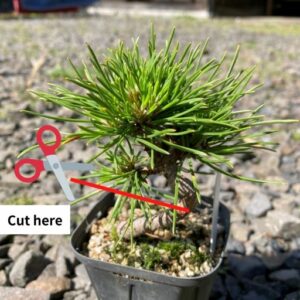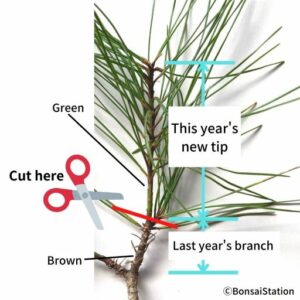Japanese black pine care: summary
| Common name | Japanese black pine |
| Latin name | Pinus thunbergii |
| Native area | Japan, Korea |
| Cold tolerance | High |
| Heat tolerance | High |
| Drought tolerance | High |
| Sun exposure | Full sun (6+hours/day) |
| Soil mix | Akadama: 50% River sand/pumice: 50% |
| Repotting | Every 3-5 years |
| Fertilization | Once each in Mar, May, July, end Aug, Oct |
| Watering | Once every other day in spring and fall Once/day in summer Once every 3 days in winter |
| Life span | Over 500 years |
Japanese black pine care
Placing
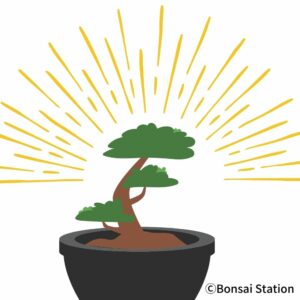
Japanese black pine bonsai should be placed outside under the sun where it can get at least 6 hours of sunlight a day and enough airflow.
Sunlight
Japanese black pine is a sun-loving tree. Whether a sapling or a mature tree, they like sunlight and hate being in shade. If they are put in a place without enough sunlight, their branches wither, and leaves start to fall off. Once it happens, new leaves might not sprout, and branches may die off.
Make sure to rotate the pots once a month so that the entire tree is evenly exposed to the sun.
Airflow
Airflow is also important. Although Japanese black pines are quite immune to pests, infestation may occur in places where air is always stagnant. Also, less transpiration from the leaves may result in poor growth.
In winter
Japanese black pines are resistant to the cold, but if the temperature is low enough to freeze the soil, you need to keep them in a place where the soil does not freeze.
Repotting
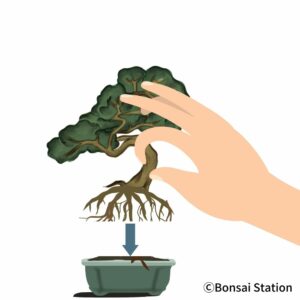
Frequency of repotting
Young Japanese black pine bonsai trees should be repotted every 2 to 3 years. Fully-grown black pine bonsai is to be repotted every 3 to 5 years.
When to repot
When they are repotted just before new buds appear in early spring, new roots will grow immediately after repotting, minimizing the loss of tree vigor due to repotting. Young and fast growing black pine bonsai can be repotted during May and June, late summer, and in winter, but root recovery will be slower than in spring.
Soil mix
The best soil mix for Japanese black pine bonsai is;
- Akadama: 50%
- River sand/pumice: 50%
Drainage is very important for Japanese black pine bonsai and no organic matter is needed. Nutrients should be given as fertilizer.
How to repot
1. Before repotting, refrain from watering for a while. Dry the soil to make it easier to remove the tree from the pot.
2. To remove the tree from the pot, tap the outer rim of the pot with your hand to loosen the soil. If that does not work, put a wooden chopstick between the soil and the inner side of the pot and gently pull the tree out.
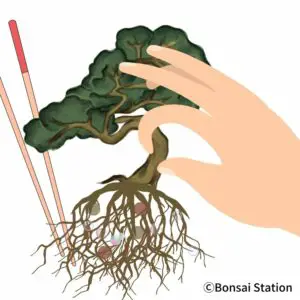
remove the soil with a chopstick
3. After pulling out the tree, use a chopstick to loosen the tangled roots at the bottom. The old soil attached to the roots should be removed by 60% for younger trees and 50% for older trees.
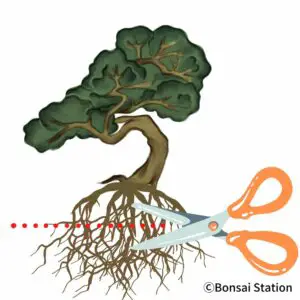
Prune the roots.
4. Cut fine roots by about an inch (3 cm). Bigger roots should be cut off from the previous cut.

5. Once the soil and roots have been cleaned up, the tree is ready to be repotted in a new pot. Choose a pot that has a good balance with the tree.
6. Place a bottom net in the drainage holes. Put large grains of Akadama soil in the bottom for drainage. Put half of the soil mix on top of it.
7. Put the tree in the pot and decide the position.
8. Once the position of the tree is determined, fill the surrounding of the tree with soil. Poke in the soil with a chopstick so that the pot is filled with the soil fully without air gaps.
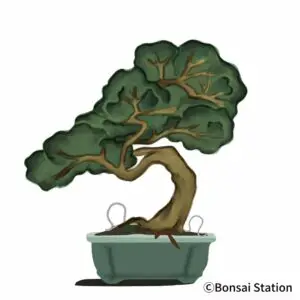
Secure the tree using wires/strings.
9. If the tree has a large above-ground portion, wire the tree with the pot at the base for stability.
After repotting, water the tree well so that it overflows from the bottom of the pot. Place the tree in a semi-shaded area without wind for a week and water the leaves 2-3 times a day. Gradually bring them out to the sun.
Do not fertilize until roots are regrown and well developed (1-2 months after repotting).
Watering
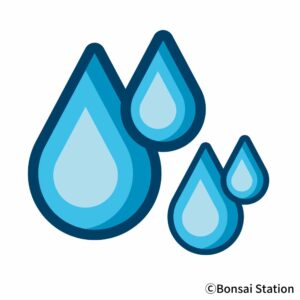
Japanese black pine is relatively resistant to drought and does not like the soil always moist. Drainage of the soil is important for black pines because root rot will likely occur if the drainage is poor and water stagnates in the pot.
Generally, Japanese black pine bonsai should be watered;
- Once every other day in spring and fall,
- Once/day in summer, and
- Once every 3 days in winter.
When watering, give plenty at once. This will allow air to circulate in the soil as well as water. Giving only a small amount of water will only reach the surface of the soil and the air will not reach the roots.
During winter, water in the morning to allow the water in the pot to drain and dry in the evening to prevent the soil in the pot from freezing.
Fertilizing
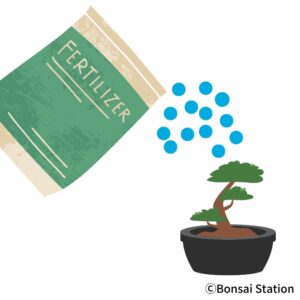
Young and in-training Japanese black pines need a little more nitrogen to promote growth. Less nitrogen is necessary for full-grown bonsai trees to enhance the appearance of rough bark.
If there is a rainy season in your region, refrain from fertilizing as the tree may be weakened with too much water in the soil, and giving nutrition at this time may cause fertilizer burn.
Begin applying fertilizer in April, and continue to give once a month during the growing season except for the rainy season, if any.
Styling
To encourage ramification
Japanese black pine trees, especially young and vigorous ones, tend to overgrow new shoots. If they are left unattended, they become elongated branches without ramification and no fine branches will increase from those shoots.
So, it is necessary to prevent the shoots from overstretching and encourage the tree to grow new branches.
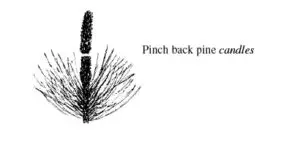
pinching pine candle
(Source: Virginia State University)
To do this, pinch the new shoots by half when they have come out while the new leaves have not yet opened. The new shoots of Japanese black pines look like candles covered with hair-like scales. Vigorous and big shoots can be pinched back nearly at the base. Small shoots with poor growth, on the other hand, should be left unpinched.
If several shoots are coming out in one place, remove the smaller shoots from the base and leave a couple of shoots that look good for new branching.
In about 2 weeks, 1 to 3 new shoots will appear around the shoots that are pinched.
To shorten leaves
When Japanese black pine is made into a bonsai, the needle leaves are unusually long for a bonsai tree because the length of the leaves is almost the same as those on trees planted in the ground.
To match the size of the leaves to the height of the tree, the leaf length should be shortened by leaf cutting and tip pruning.
Leaf cutting
Pruning of new leaves for Japanese black pine bonsai shortens the leaf length of the year you do the pruning. As the tree vigor declines, the next year’s leaves will also be shorter.
Leaves of younger trees should be cut harder (like half) and those of older trees softer. You do not have to cut all the leaves at the same length.
The best time for leaf cutting is before summer, from mid-June to early July. The timing is important because if it is too early, the tree’s vigor will recover and the next year’s leaves will be as long as before. Conversely, if it is too late, the vigor of the tree may drop more than necessary.
After leaf cutting, be careful not to overwater your tree as bonsai trees with fewer leaves do not need as much water as usual due to less evaporation from leaves. Watering should be done when the soil is dry rather than on schedule until new leaves start to come out.
Tip pruning
Tip pruning allows the tree to grow shorter leaves and is different from the usual pinching of new shoots which is done to encourage ramification. By cutting off newly grown tips, the vigor of the next buds will be weakened and the leaves will be shorter.
How to tip pruning
When new tips have grown, prune all new tips off. Cut with pruning shears slightly above the border of the previous year’s branch so that the base of the new tips remains a little. In about two weeks, new shoots will appear from the top.
Tip pruning should be done separately 4 times, starting from the bottom to the top every 2 days. Since tree vigor is stronger at the top, this will even out the overall vigor of the tree when new shoots appear. All the leaves will be open around October.
If there are partially weakened branches, do not prune them. Or you can prune that branches about a week earlier. In this case, cut half of the new tips, not all, leaving the new shoots at the tip of the branch. This will allow the branch to grow back and restore its momentum
When to tip pruning
Tip pruning should be done from June to early July when the new tips have fully grown. The timing is important. If done too early, the leaves will be a normal size and the pruning will not be effective. If done too late, it will get cold before the new leaves can fully grow.
This procedure is very stressful to the trees because pruning new shoots directly suppresses the growth point of the plant. As such, it cannot be done to already weakened trees. And, it cannot be done every year as well. Once every 2 to 3 years is acceptable for most of the trees.
Wiring
The best time to wire Japanese black pine bonsai trees is in winter when they are dormant until just before the start of growth activity, except during the very cold season. Trees will recover faster from strong wiring if it is done before sprouting.
As pruing, wiring large branches during the growing season may cause tree sap to stop flowing properly and to wither.
Old branches of black pine bonsai can also be adapted by wiring but strong bending may hurt the old branches to weaken. Try to wire softly and bend them over several years until you get the styling you want.
When bending big branches or the trunk, copper wires allow for stronger bends than aluminum wires. It is important to set the direction of your choosing and make the wire work properly. Small cracks for Japanese black pine bonsai are OK as long as the branches or the trunk absorbs water. The wound will heal eventually.
Infestation
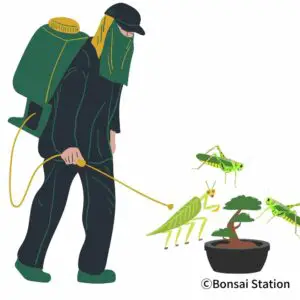
Japanese black pines are quite strong but new shoots may be susceptible to aphids, scale insects, and pine beetles.
Also, when both the temperature and humidity are high, leaf sieve disease and leaf blight may occur by pathogens or fungi. If infected, light brown lesions appear on the leaves, which eventually fall off.
Diseases of Japanese black pine bonsai tend to occur when the soil stays wet by prolonged rain or overwatering. It may also happen when there is not enough airflow around the trees to keep them dry. Wet soil causes root rot and trees will weaken.


